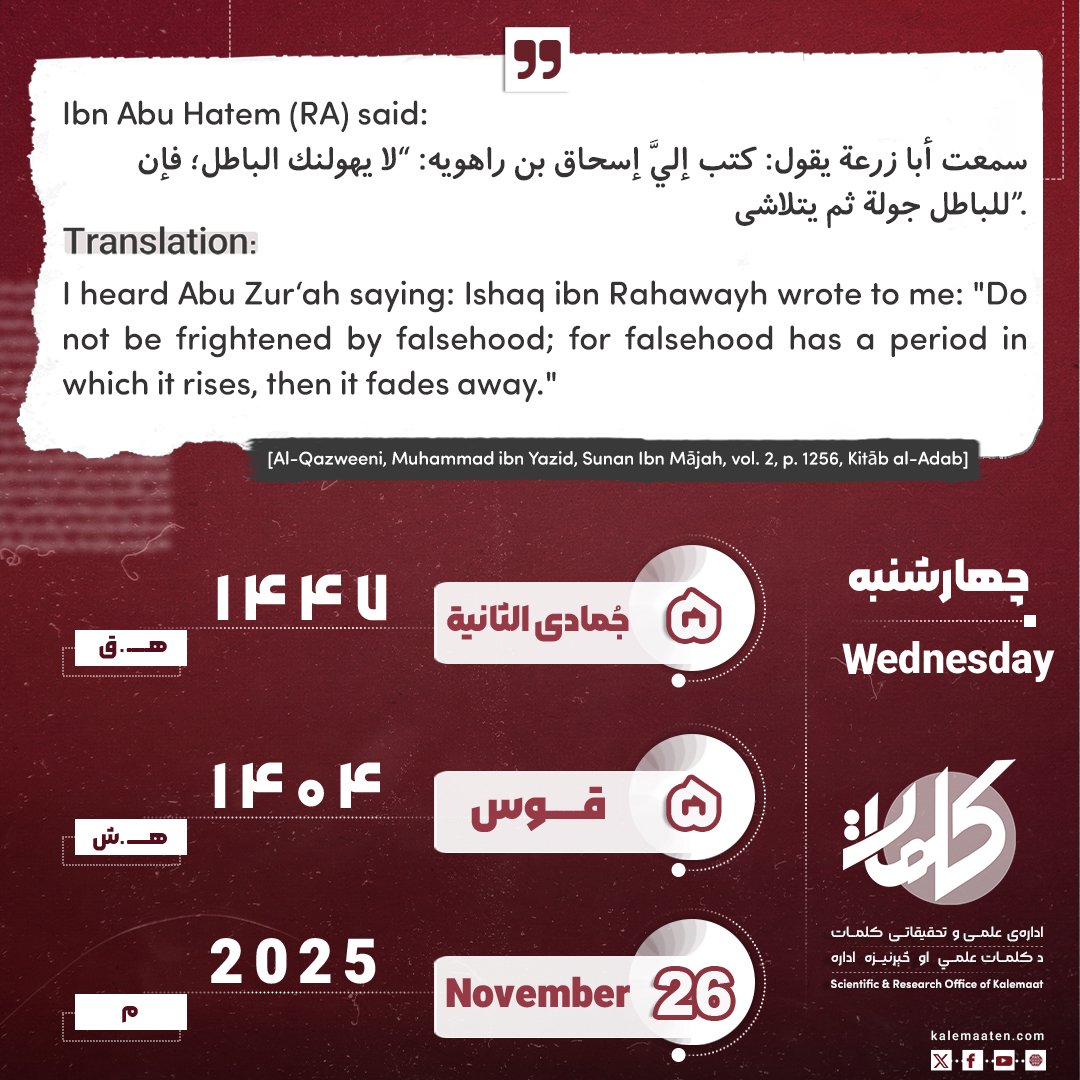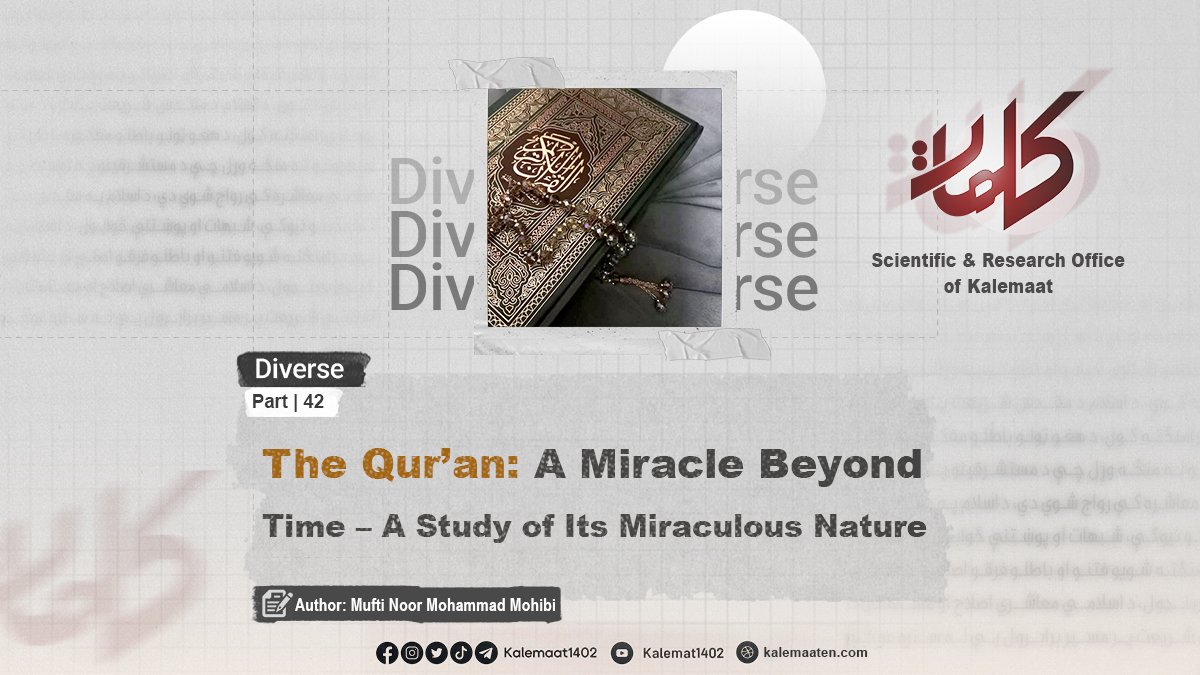Author: Mufti Noor Mohammad Mohibi
The Quran: A Miracle Beyond Time- A Study of Its Miraculous Nature (Part 42)
The Stages of Fetal Development in the Light of Revelation and Modern Science
The Holy Qur’an, in its precise and eloquent expression, refers to subtle points regarding the process of human formation and the detection of pregnancy. In a verse from Surah Al-Baqarah, Allah says: “وَٱلَّذِینَ یتَوَفَّوْنَ مِنكُمْ وَیذَرُونَ أَزْوَٰجًا یتَرَبَّصْنَ بِأَنفُسِهِنَّ أَرْبَعَةَ أَشْهُرٍ وَعَشْرًا” [1] Translation: “And those among you who die and leave wives behind them, they (the wives) shall wait by themselves for four months and ten days.”
In this verse, the waiting period (‘iddah) for widows is specified precisely as four months and ten days. This determination is not merely a legal ruling but also corresponds astonishingly with modern scientific findings on fetal development. Medical experts state that pregnancy, in terms of clinical diagnosis, is divided into three stages:
1. The Stage of Doubt
At the beginning of pregnancy, the first sign is usually the cessation of menstruation. Although this may indicate pregnancy, it is not conclusive evidence since hormonal imbalances, psychological stress, or gynecological disorders may cause the same symptom.
2. The Stage of Suspicion
At this stage, the woman may experience nausea, vomiting, loss of appetite, mood swings, or a tendency toward isolation. This combination of symptoms, commonly referred to as wahm (craving or false pregnancy), increases the likelihood of pregnancy but still cannot confirm it definitively.
3. The Stage of Certainty
Around the 126th day of pregnancy (four months and ten days), the fetus’s heartbeat begins to form, and the mother feels its movements. This marks the point of certain pregnancy — fully corresponding to what the Qur’an specifies. Thus, the Qur’anic verse precisely indicates the moment of scientific certainty in pregnancy, showing a remarkable harmony between divine revelation and modern medical knowledge.
The Miracle of the Amniotic Fluid
In another verse, Allah the Almighty delicately mentions the conditions of fetal development within the womb: “يَخْلُقُكُمْ فِي بُطُونِ أُمَّهَاتِكُمْ خَلْقًا مِّن بَعْدِ خَلْقٍ فِي ظُلُمَاتٍ ثَلَاثٍ” [3] Translation: “He creates you in the wombs of your mothers, creation after creation, within three layers of darkness.”
Modern embryology identifies these three layers of darkness as:
-
The abdominal wall,
-
The uterine wall,
-
The fetal membranes — including the amniotic membrane (amnion).
Among these layers, the amniotic membrane is of particular significance. It forms a closed, transparent sac that contains a clear fluid known as amniotic fluid, which reaches up to 1.5 liters by the seventh month of pregnancy and decreases to about one liter near delivery.
The amniotic fluid surrounds the fetus within the amniotic sac and serves multiple vital functions:
Scientific Benefits of Amniotic Fluid
-
Nutrition:
It contains proteins, sugars, and minerals that contribute to the nourishment of the fetus.
-
Protection from Shock:
It acts as a natural cushion, evenly distributing external pressure or impact on the mother’s abdomen — similar to the protective fluids used in aerospace technology.
-
Facilitating Movement:
The fluid allows the fetus to move freely without friction, essential for the proper development of its muscles and bones.
-
Thermal Stability:
It provides a stable temperature environment, protecting the fetus from external fluctuations.
-
Preventing Adhesion:
Without this fluid, the fetus could adhere to the internal membranes, causing congenital defects.
-
Ease of Childbirth:
During labor, it acts as a natural lubricant, facilitating the passage of the baby through the birth canal.
-
Cleansing the Birth Path:
The early discharge of the amniotic fluid helps disinfect the delivery passage, preventing infections from entering the infant’s body.
All these scientific realities are miraculously encompassed in the Qur’anic verse: “يَخْلُقُكُمْ فِي بُطُونِ أُمَّهَاتِكُمْ خَلْقًا مِّن بَعْدِ خَلْقٍ فِي ظُلُمَاتٍ ثَلَاثٍ” [4] Translation: “He creates you in the wombs of your mothers, creation after creation, within three layers of darkness.”
Conclusion
In conclusion, as explained in this discussion, the modern scientific findings on amniotic fluid, the stages of pregnancy detection, and fetal development not only align with experimental and clinical discoveries but also astonishingly correspond with the expressions of the Holy Qur’an. The Qur’anic precision in phrases such as “أَرْبَعَةَ أَشْهُرٍ وَعَشْرًا” [5] and “يَخْلُقُكُمْ فِي بُطُونِ أُمَّهَاتِكُمْ خَلْقًا مِّن بَعْدِ خَلْقٍ فِي ظُلُمَاتٍ ثَلَاثٍ” [6] reveals a truth that Allah the Exalted declares:
“سَنُرِيهِمْ آيَاتِنَا فِي الْآفَاقِ وَفِي أَنفُسِهِمْ حَتَّىٰ يَتَبَيَّنَ لَهُمْ أَنَّهُ الْحَقُّ” [7] Translation: “We shall show them Our signs in the horizons and within themselves until it becomes clear to them that it is the truth.”
This scientific miracle not only strengthens the faith of believers but also opens the door to profound reflection on the wisdom and omnipotence of the Almighty Creator.
Continues…
Previous Part
References:
[1]. Al-Baqarah: 234.
[2]. Wahm — the strong craving or desire of a pregnant woman.
[3]. Az-Zumar: 6.
[4]. Az-Zumar: 6.
[5]. Al-Baqarah: 234.
[6]. Az-Zumar: 6.
[7]. Fussilat: 53.
[8]. Extracted from Encyclopedia of Scientific Miracles in the Qur’an and Sunnah, Vol. 1, pp. 91–95.



